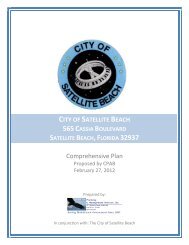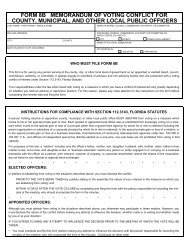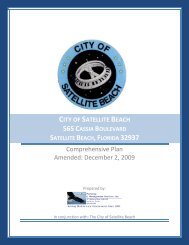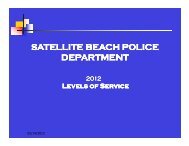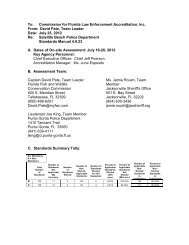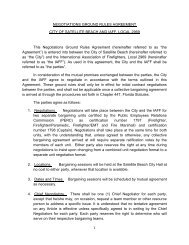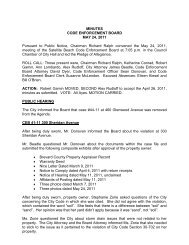Supporting Documents (Data and Analysis) - Satellite Beach
Supporting Documents (Data and Analysis) - Satellite Beach
Supporting Documents (Data and Analysis) - Satellite Beach
Create successful ePaper yourself
Turn your PDF publications into a flip-book with our unique Google optimized e-Paper software.
capacity of 26.5 MGD. On a typical day, dem<strong>and</strong> for water is about 15.2 MGD. The City of<br />
Melbourne has a diversified water-supply approach, using both groundwater <strong>and</strong> surface water to<br />
make sure high-quality water is always available when needed.<br />
The Florida Department of Environmental Protection (FDEP) has performed a Source Water<br />
Assessment on Melbourne’s system. This assessment was conducted to provide information about<br />
any potential sources of contamination in the vicinity of our wells <strong>and</strong> surface water intakes.<br />
Potential sources of contamination identified include underground petroleum storage tanks, dry<br />
cleaning facilities, <strong>and</strong> domestic wastewater sites. Melbourne’s state-certified laboratory<br />
continuously analyzes water quality throughout the treatment process to ensure superior quality<br />
drinking water is delivered to their customers. The state allows Melbourne to sample for some<br />
contaminants less than once per year because the concentrations of these contaminants do not change<br />
frequently. In Melbourne’s state-certified water quality laboratory, professional technicians perform<br />
tens of thous<strong>and</strong>s of chemical <strong>and</strong> bacteriological tests on water samples each year. The results of<br />
this rigorous testing continually confirm that Melbourne’s water is safe to drink.<br />
Melbourne's water quality continues to exceed the st<strong>and</strong>ards set forth by both the federal<br />
Environmental Protection Agency <strong>and</strong> the State Department of Environmental Protection.<br />
Melbourne's water has fluoride added, which meets the optimum fluoride level guidelines as required<br />
by law.<br />
The overall water distribution system consists of approximately 1,100 miles of six- to 36-inch<br />
diameter transmission mains, <strong>and</strong> about 1,000 miles of two to six-inch diameter distribution piping.<br />
The city is continuing to upgrade the distribution system in accordance with its water distribution<br />
system master plan.<br />
There are two 20-inch pipelines that cross the Intracoastal Waterway to provide service to <strong>Satellite</strong><br />
<strong>Beach</strong>. One crossing is an aerial/sub-aqueous crossing located along Melbourne Causeway over the<br />
Indian River, <strong>and</strong> the second crossing is a sub-aqueous crossing of the Indian River located<br />
approximately 3/4 miles south of the Eau Gallie Causeway. On the beach side, a 12-inch pipe runs<br />
north to <strong>Satellite</strong> <strong>Beach</strong> along South Patrick Drive, <strong>and</strong> a 16-inch pipe runs along SR A1A. Potable<br />
water is stored throughout the distribution system to help meet peak dem<strong>and</strong>s <strong>and</strong> provide for fire<br />
flow. Both elevated <strong>and</strong> ground storage tanks are provided. The capacity of these range from 250,000<br />
to 2.0 million gallons, with an aggregate storage capacity of 14.5 million gallons. Local aboveground<br />
storage tanks are located near the intersection of the Eau Gallie Causeway <strong>and</strong> State Route<br />
A1A, <strong>and</strong> immediately north of the City's northerly limits, near the Atlantic Plaza Shopping Center.<br />
Melbourne maintains continuous flow monitoring at the Lake Washington Water Production<br />
Facilities; this flow monitoring occurs at the point of entry to the distribution system. In addition,<br />
continuous flow monitoring is maintained at the three booster pumping stations when they are in use.<br />
These are the North Booster Pumping Station, the Canova <strong>Beach</strong> Booster Pumping Station, <strong>and</strong> the<br />
Hibiscus Booster Pumping Station. Finally, flow monitoring is provided at the four elevated water<br />
storage tanks. However, only the Patrick Elevated Water Storage Tank contributes flow in <strong>and</strong> out of<br />
the distribution system on a regular basis.<br />
Infrastructure Element<br />
<strong>Data</strong> <strong>and</strong> <strong>Analysis</strong> 4-10



